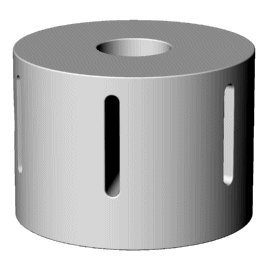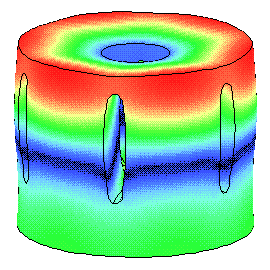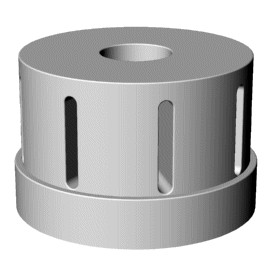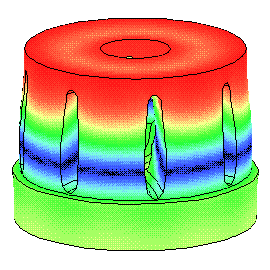For cylindrical horns whose diameter is greater than about 0.5 *
wavelength (about 5" at 20 kHz), longitudinal slots must be used to reduce the
transverse coupling due to the Poisson effect. Such slots are usually radial, although
other configurations are sometimes useful. Without such slots the horn will either have
very uneven amplitude across the face or may even resonate in a nonaxial manner. Slotted
cylindrical horns generally have low-to-moderate gain (1:1 to 2:1). Cylindrical horns are
used for plunge welding.
Example
The following example shows a 20 kHz 6.5" diameter slotted cylindrical horn. The
horn has a face cavity that extends deep within the horn in order to increase its gain.
The axial resonance is the desired resonance. The horn is one half-wavelength long at
axial resonance, as indicated by the single node that is generally transverse to the
principal direction of vibration.
For all images, the output surface (face) is at the top and the input surface is at the
bottom. The warmest colors indicate the highest amplitudes. The darkest color traces the
axial node(s).
All results are from finite element
analysis.
Original design
The following shows the original (unoptimized) design and the resulting amplitude
distribution.
 |
Original design -- No optimization |
|
|
 |
Axial resonance, relative amplitudes -- The
amplitude at the outer face is much higher than at the center. This will cause
over-welding at the outside or reduced welding at the center. View actual vibration
|
Improved design
The following shows an improved design that has substantially better amplitude
uniformity across the horn's face.
 |
Improved design -- Uses
optimized cavity, slots, and back extension
|
|
|
 |
Axial resonance, relative amplitudes
-- The amplitude is now very uniform across the horn's face.
View actual vibration
|
Design considerations
Although the slots help to improve the face amplitude uniformity, other refinements are
often necessary to further improve the uniformity, depending on the particular
application. Also, the required slots can introduce additional secondary resonances and
can cause stress problems, although these problems can be reduced through careful design.
(Note: depending on the application requirements, many smaller diameter horns will not
require slots. For example, see spool horns.)
Secondary resonances
Slots often introduce additional secondary resonances. The following image shows a
typical secondary resonance, although many others are possible.
Such secondary resonances may interfere with the vibration of the axial
resonance. In some cases, the power supply may prefer to start on a secondary resonance or
may jump to a secondary resonance during the weld cycle. The effects of secondary
resonances can be minimized by designing the horn so that the secondary resonances are
sufficiently far from the axial resonance.
Slot stresses
In slotted cylindrical horns, the stresses are generally highest at the end of the
slots. The cause of this problem can easily be seen by watching the slots deform as
the horn vibrates (see the animation). High cyclic
stresses can cause the horn to fail by fatigue. This problem can be reduced by proper slot
design and by machining the horn from high-strength materials.